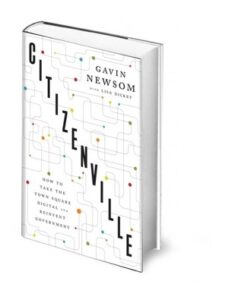
Over the next 18 months, VCRD’s Digital Economy Project will be working to help Vermont communities, businesses and nonprofits become more resilient to natural and manmade disasters. The project will also explore ways to systematically use technology to reshape volunteer management and disaster recovery efforts, and to transform the relationship between citizens and government. Our ultimate goal is to facilitate the use of technology to improve lives in Vermont.
This goal is shared by California Lieutenant Governor Gavin Newsom, whose new book Citizenville provides a roadmap for government officials, organizations, communities, and internet activists looking to take the town square digital and reinvent government. The book is a call to action for governments to embrace decentralized models and to create new, more effective, and often less expensive ways to provide residents with services and to engage with government agencies.
In his book, Newsom calls for providing open access to the troves of government data sitting in filing cabinets or on hard-drives, then letting average citizens, for-profits and nonprofits use the data to create websites and apps to improve governance and service delivery. According to Newsom, the idea is to use technology to create new feedback loops so people can take an active part in every facet of governing.
The book is an encyclopedia of examples of local governments and everyday citizens leveraging existing data and web skills to solve problems and improve their communities. These efforts include a successful effort to reduce muggings by using police data to map crime to a Texas town. This town drummed up civic engagement by inventing a digital currency, similar to that used by the online game Farmville, to reward citizens for participating in government.
Wouldn’t it be nice if communities could know exactly where all the frost heaves were this spring, and then have a way to expediently repair them? Volunteers in some towns are using a mobile application called Street Bump to collect road condition data while they drive. This data is then used by local governments to fix problems. Other applications that were created after data was released allow volunteers to mark street lights that are out, drains that are clogged, or trash that needs to be cleaned up. Adopt-A-Hydrant provides a way for residents to claim responsibility for shoveling out a fire hydrant after it snows. The San Ramon Valley Fire Protection District dispatches CPR trained citizens to cardiac emergencies occurring nearby. The possibilities are endless!
Here at the Digital Economy Project, we want to hear your ideas on how communities in Vermont can and are using digital tools to solve community problems. Please share your examples below, or email them to [email protected].
